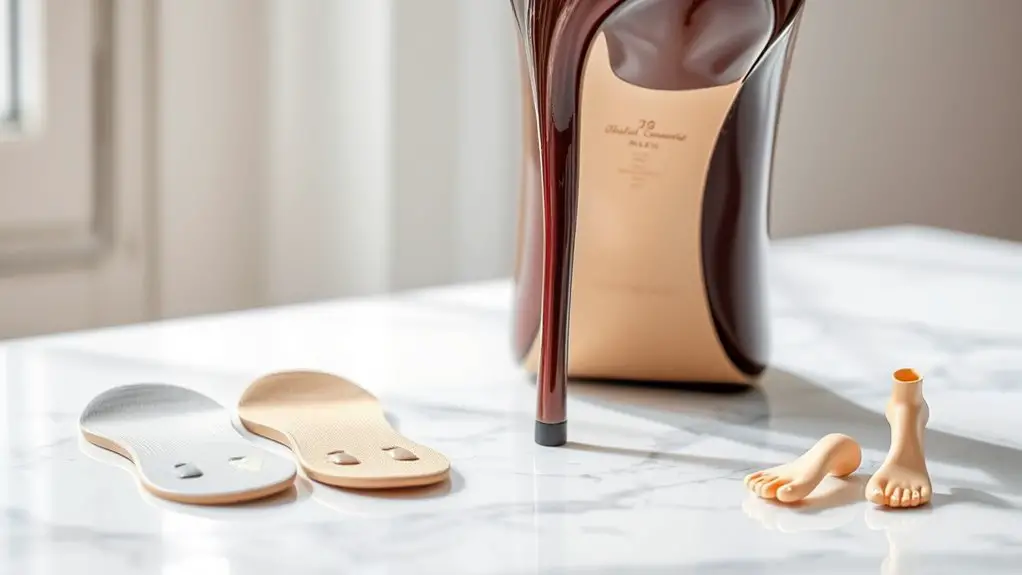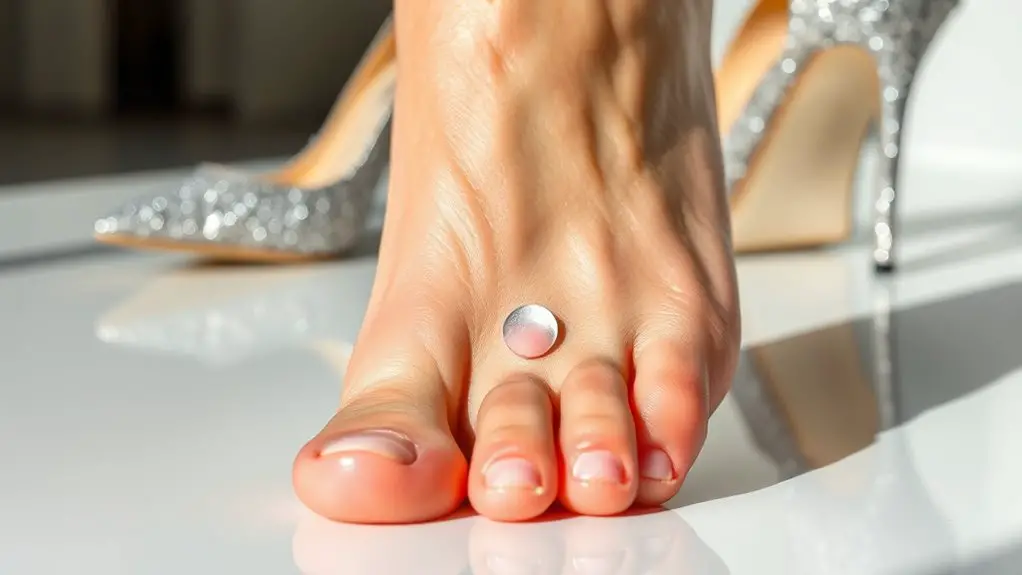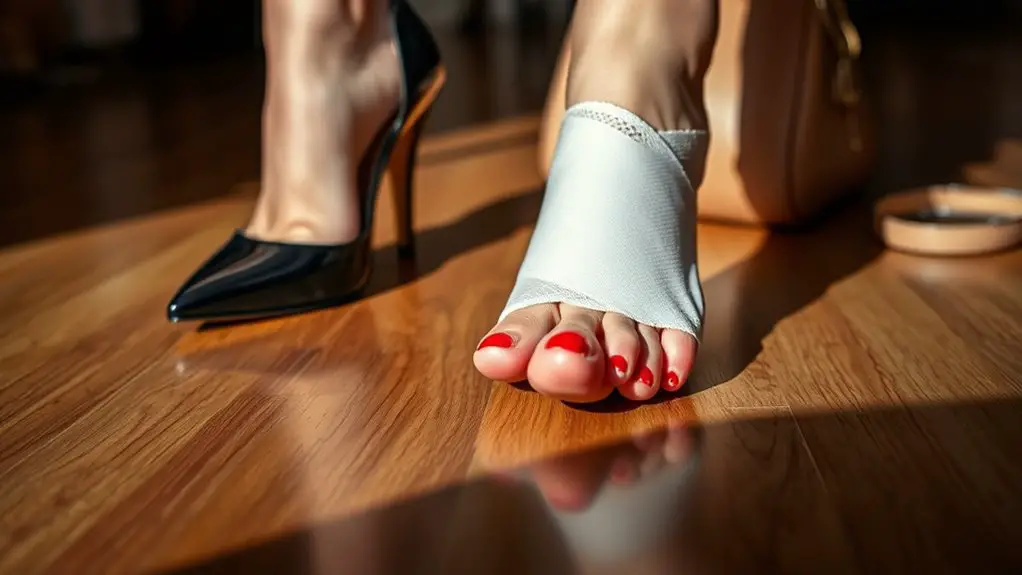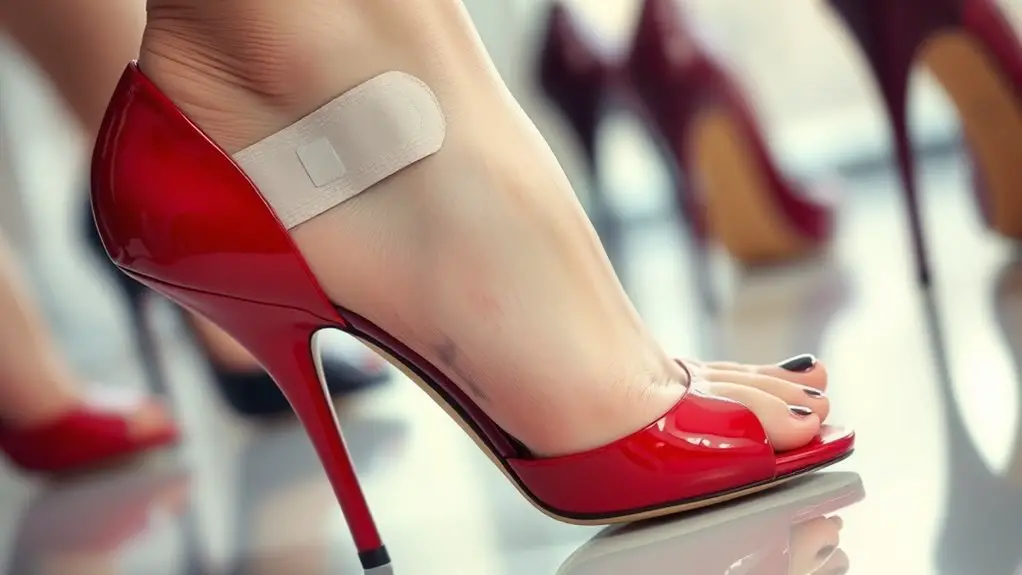High heels can lead to injuries like sprained ankles, plantar fasciitis, and Morton’s neuroma due to altered foot mechanics and increased pressure on specific areas. To avoid these issues, opt for lower heels with a wider base, prioritize cushioning and arch support, and guarantee a proper fit. Stretch your calves regularly and alternate between high heels and more supportive footwear. For more insights into managing high heel-related injuries and selecting safer options, there’s more to explore.
Understanding the Anatomy of High Heels

High heels, a popular choice for many, are designed with specific anatomical features that greatly influence their wearability and potential for injury. The heel design typically elevates the posterior of the foot, altering foot biomechanics noticeably. This elevation shifts weight distribution, concentrating pressure on the forefoot and increasing the risk of discomfort and injury over time.
Understanding foot biomechanics is essential when evaluating high heel wear. The angle created by the heel height can lead to shortened Achilles tendons and altered gait patterns, which may contribute to various musculoskeletal issues. Additionally, the narrow toe box found in many high heels can compress the toes, exacerbating conditions like bunions and neuromas.
Sprained Ankles: Causes and Prevention
Wearing high heels can considerably increase the risk of ankle sprains due to the altered biomechanics they impose. The elevated height and narrow toe box of high heels compromise ankle stability, making it easier to roll or twist your ankle, especially on uneven surfaces. To prevent sprains, prioritize thoughtful footwear selection. Opt for heels with a lower height and a wider base, as these features enhance stability. Additionally, consider shoes with ankle straps, which provide extra support to keep your foot securely in place. Strengthening your ankle and leg muscles through targeted exercises can also mitigate injury risk. When walking, maintain a careful gait, and be mindful of your surroundings to avoid sudden movements that could lead to sprains. By taking these precautions, you can enjoy your high heels while reducing the likelihood of ankle injuries.
Blisters: Identifying and Avoiding Friction

While they may elevate your style, high heels can also lead to painful blisters due to friction between your skin and the shoe material. To minimize this risk, it’s essential to focus on blister prevention and friction reduction strategies.
Start by choosing high-quality shoes that fit well; ill-fitting heels are more likely to cause friction. Consider using moisture-wicking socks or foot sleeves made from silicone or gel, which can provide an additional layer of protection between your skin and the shoe. Applying blister prevention products, such as blister pads or protective ointments, can further reduce friction and cushion your feet.
Additionally, break in new shoes gradually to allow your feet to acclimate. Regularly check for signs of excessive rubbing or irritation and adjust your footwear choices accordingly. By being proactive, you can enjoy your high heels without suffering from painful blisters.
Plantar Fasciitis: Long-Term Effects of High Heel Wear
Wearing high heels can lead to plantar fasciitis, a condition characterized by heel pain and discomfort. You may experience symptoms like sharp pain with your first steps in the morning or after prolonged sitting. To prevent this issue, it’s crucial to employ strategies such as choosing supportive footwear and incorporating stretching exercises into your routine.
Symptoms of Plantar Fasciitis
Many people who frequently wear high heels may experience symptoms of plantar fasciitis, a condition that can lead to significant discomfort. Common symptoms include sharp heel pain, especially with the first steps in the morning or after prolonged sitting. You might also notice stiffness along the arch of your foot and swelling. Recognizing these symptoms early is essential for effective treatment options.
| Symptom | Description | Impact on Daily Life |
|---|---|---|
| Heel Pain | Sharp pain at the bottom of the heel | Difficulty walking |
| Stiffness | Tightness in the arch or heel | Limited mobility |
| Swelling | Inflammation at the plantar fascia | Discomfort in footwear |
| Tenderness | Sensitivity when pressure is applied | Pain during activities |
| Foot Fatigue | Increased tiredness in foot after activity | Reduced activity levels |
Understanding plantar fasciitis causes and treatment options can help you manage symptoms effectively.
Prevention Strategies for Pain
To effectively prevent pain associated with plantar fasciitis from high heel wear, it’s crucial to adopt certain strategies that can mitigate stress on your feet. First, choose high heels with adequate footwear flexibility; this allows your foot to move more naturally, reducing strain. Look for shoes that provide proper arch support, which helps distribute weight evenly and alleviates pressure on the plantar fascia. Additionally, consider alternating between heels and supportive flats to give your feet a break. Regularly stretching your calves and feet can also enhance flexibility and reduce discomfort. Finally, limit your time in high heels and listen to your body’s signals to avoid exacerbating any existing pain. These preventive measures can greatly decrease your risk of developing long-term issues.
Metatarsalgia: Pain in the Ball of the Foot

Metatarsalgia refers to pain in the ball of your foot, often exacerbated by high heels. Common symptoms include sharp or aching discomfort, particularly during weight-bearing activities. Understanding the causes and implementing prevention techniques can help you manage and reduce this condition effectively.
Symptoms and Causes
Pain in the ball of the foot, known as metatarsalgia, can greatly impact your daily activities. This condition often manifests as sharp or aching pain in the forefoot, particularly during weight-bearing activities. You may also experience swelling or a burning sensation in that area. Metatarsalgia can arise from various causes, including excessive pressure on the metatarsal bones due to high heels or inadequate cushioning in your footwear choices. Heel discomfort is frequently associated with this condition, as wearing shoes that lack arch support can exacerbate the symptoms. Overuse, obesity, or foot deformities like bunions can also contribute to metatarsalgia. Understanding these symptoms and causes is essential in addressing the pain effectively.
Prevention Techniques
While wearing high heels can be stylish, there are effective prevention techniques to help minimize your risk of developing metatarsalgia. First, choose proper footwear with adequate cushioning and support to reduce pressure on the ball of your foot. Look for shoes with a wide toe box and lower heel height to distribute weight evenly.
Incorporating stretching exercises into your routine is also essential. Focus on calf stretches and toe flexors to enhance flexibility and relieve tension in your feet. Additionally, consider using metatarsal pads to provide extra cushioning where it’s needed most. By prioritizing proper footwear and regularly performing stretching exercises, you can notably decrease your chances of experiencing pain in the ball of your foot while enjoying your high heels.
Hammertoes: How High Heels Contribute to Deformities
High heels may elevate your style, but they also greatly increase the risk of developing hammertoes, a painful deformity characterized by an abnormal bend in the toe. The elevated position of high heels forces your toes into a cramped space, leading to muscle imbalances and tendon tightening. To mitigate this risk, it’s vital to make informed footwear choices, prioritizing shoes that provide a proper fit and adequate toe space.
Incorporating toe exercises into your routine can strengthen the muscles and improve flexibility, helping to prevent or manage hammertoes. If you do experience symptoms, hammertoe treatment may include changing footwear, using orthotics, or engaging in specific exercises designed to relieve discomfort. By being mindful of your shoe selections and integrating preventative measures, you can maintain both style and foot health, avoiding the long-term consequences of improper footwear.
Achilles Tendonitis: The Impact of Heel Height
When wearing heels, you may unknowingly place excessive strain on your Achilles tendon, leading to a condition known as Achilles tendonitis. The higher the heel height, the more your foot is positioned in a downward angle, which can shorten and tighten the tendon over time. This unnatural angle increases tendon strain, making it more susceptible to inflammation and pain.
If you frequently wear high heels, consider alternating with lower footwear to alleviate stress on your Achilles tendon. Stretching exercises for your calf muscles can also help maintain flexibility and reduce the risk of tendonitis. Pay attention to heel height; even a slight reduction can greatly decrease the strain on your tendon. Remember, the longer and more frequently you wear high heels, the greater the risk of developing Achilles tendonitis and other related injuries. Prioritizing comfortable footwear can help protect your feet and overall well-being.
Stress Fractures: Recognizing the Signs
Excessive strain on the feet from high heels can lead to various injuries, including stress fractures. Recognizing stress fracture symptoms early is vital for effective management. Common signs to watch for include:
Excessive strain from high heels may cause injuries like stress fractures, making early symptom recognition crucial for effective management.
- Persistent pain in the foot that worsens with activity
- Swelling or tenderness in specific areas
- Difficulty bearing weight or walking
- Bruising or redness around the affected area
- A sensation of localized heat
To prevent these injuries, consider implementing the following prevention strategies:
- Alternate between high heels and more supportive footwear
- Limit the duration of high heel use
- Gradually increase heel height to allow your feet to adapt
- Strengthen foot and ankle muscles through targeted exercises
- Pay attention to body mechanics while walking
Nerve Compression: Understanding Morton’s Neuroma
Morton’s neuroma is a painful condition caused by nerve compression between the toes, often exacerbated by high heels. You may experience symptoms like sharp pain, tingling, or numbness in the affected area, which can be diagnosed through a physical examination and imaging tests. Understanding the risk factors and exploring treatment options is essential for effective management and relief.
Symptoms and Diagnosis
Although high heels can enhance your appearance, they can also contribute to nerve compression issues, such as Morton’s neuroma. Accurate symptom recognition is vital for effective management. Common symptoms include:
- Sharp, burning pain in the ball of your foot
- Tingling or numbness in your toes
- A feeling of having a pebble in your shoe
- Pain that worsens with high-heeled shoes
- Discomfort that improves when removing footwear
To reach a diagnosis, healthcare professionals may employ various methods. These include physical examinations, imaging studies like ultrasounds or MRI, and nerve conduction tests. Early diagnosis can prevent further complications and enhance your comfort, allowing you to enjoy fashionable footwear with minimal pain.
Risk Factors Involved
When it comes to nerve compression issues like Morton’s neuroma, several risk factors can increase your likelihood of developing this painful condition. High heels can exacerbate balance issues and negatively affect your foot alignment, putting excessive pressure on the nerves between your toes. Prolonged wear of narrow-toed shoes can also contribute to the compression of the metatarsal nerves, leading to inflammation. Additionally, individuals with flat feet or high arches may experience altered foot mechanics, further increasing their risk. Obesity can add extra stress on your feet, while certain activities that involve repetitive impact can also heighten vulnerability. Understanding these factors can help you make informed choices about footwear and foot care to minimize your risk of Morton’s neuroma.
Treatment Options Available
If you’re experiencing symptoms associated with nerve compression from Morton’s neuroma, several treatment options can help alleviate your discomfort. Initial approaches often focus on conservative management, but if symptoms persist, more advanced interventions may be necessary.
Consider the following options:
- Physical therapy: Targeted exercises can strengthen foot muscles and improve flexibility.
- Orthotics: Custom insoles can provide better support and reduce pressure on affected nerves.
- Corticosteroid injections: These can relieve inflammation and pain in the area.
- Activity modification: Reducing high-heel wear can relieve stress on the nerve.
- Surgical options: If conservative treatments fail, surgical intervention may be considered to relieve compression.
Consult with a healthcare professional to determine the best course of action tailored to your needs.
Tips for Choosing the Right High Heels
Choosing the right high heels is essential not only for style but also for your foot health. Start by considering heel height; a lower heel (1-2 inches) is generally safer and more comfortable for daily wear. If you prefer higher heels, limit the duration of wear to reduce strain on your feet.
Next, prioritize arch support. High heels that offer adequate arch support can mitigate discomfort and help maintain proper foot alignment. Look for shoes with cushioning in the insole to absorb shock and reduce pressure on the balls of your feet.
Additionally, guarantee the fit is snug but not overly tight, as this can lead to blisters and other injuries. Experiment with different styles, such as block heels, which provide more stability. By selecting high heels thoughtfully, you can enjoy both style and comfort while minimizing the risk of injury.
Frequently Asked Questions
Can Wearing High Heels Affect My Posture Over Time?
Yes, wearing high heels can lead to posture changes over time. The elevated position affects your spine alignment, potentially causing long-term effects like back pain and muscle imbalances, which can impact your overall health and mobility.
How Often Should I Take Breaks While Wearing High Heels?
Think of your feet as delicate flowers; they need care. To maintain foot health, take a break every hour. This break frequency helps alleviate pressure, promoting circulation and reducing discomfort while wearing high heels.
Are There Specific Heel Heights That Are Safer to Wear?
When considering heel height recommendations, low heel benefits include improved stability and reduced strain on your feet. Generally, heels under two inches are safer, minimizing injury risk while providing comfort during extended wear.
Can High Heels Cause Knee Pain as Well?
Wearing high heels can feel like walking a tightrope; they can indeed cause knee pain. Improper knee alignment increases joint stress, leading to discomfort. It’s crucial to evaluate heel height and fit to minimize these risks.
What Are the Best Stretches for High Heel Wearers?
To enhance ankle flexibility and foot strength, try calf stretches, toe raises, and ankle circles. Incorporating these exercises into your routine can help alleviate discomfort and improve overall stability when wearing high heels.



